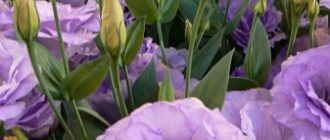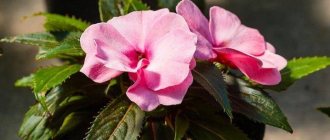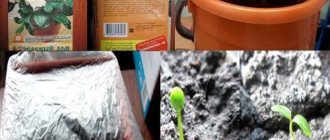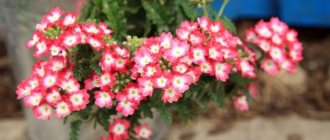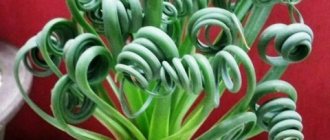Appearance
Eustoma has a strong and graceful stem, branching from the middle into a peduncle. The latter throws out up to 40 buds. The leaves of the plant are oblong, dense, and have a grayish-gray color. The height of the bush can be up to one meter. The opened buds transform into large flowers resembling roses, and when fully open they become like poppies. This was noticed by the people and eustomas were instantly nicknamed the Irish rose.
Eustoma buds resemble roses
Sometimes the plant is called “prairie bell”, due to its virgin habitats. Its homeland is considered to be:
1. Mexico.
2. States of Nebraska, Colorado, Texas.
3. Northern regions of South America.
The natural color of the petals is purple, but today, the natural version is not so easy to find. Thanks to the efforts of breeders, colorful hybrids grow in gardens. The flowering period occurs in the summer months and autumn.
Eustoma purple
Subtleties of breeding
Reproduction
Propagating a plant is not so easy. The problem is that this is not realized by dividing the bush. Adult individuals are not ready to recover from the destruction of the root system, which is an indispensable companion to the division process. The resulting divisions will also not be accepted. The cuttings also do not take root, so seeds remain the only available method of propagation for eustoma.
The optimal method of propagating eustoma is by seeds
They say that raising lisianthus seedlings from seeds is difficult, however, this is not entirely true. If you maintain optimal conditions for the seedlings in the first two months, then everything will go without incident.
When to sow?
Flower growers often sow seeds in December-January, but if you want to admire the aesthetic flowers longer, then this period should be expanded and the first batch of seeds should be placed in the ground in November. The final sowing month will be February. It makes no sense to sow eustoma later, in the spring. It simply does not have time to bloom, dying under the first snow. The secret is that the release of buds occurs at 15-20 weeks of growth, so consider whether the plant in your climate will have time to live a full cycle?
Nuances of the sowing process
It is recommended to sow seeds in disposable cups filled with a moistened soil mixture consisting of:
1. Peat soil.
2. Perlite.
3. Sand.
In this case, the soil will be looser and more breathable. If you don’t want to bother with preparing the soil, then you can purchase ready-made substrates designed for growing Saintpaulias.
Eustoma seedlings in disposable containers
Sow seeds superficially, without significant deepening. They just need to be lightly pressed into the soil. 3-5 seeds are placed in each container (calculated for picking). The seeded cups are covered with polyethylene to create a greenhouse effect and left alone until the seedlings germinate.
Just press the seeds a little into the soil
You can try another planting method, for which you will need peat tablets. Each of the tablets is soaked in water in turn. The seed is placed in the hole made, without further pressing down or sprinkling with earth. The “charged” tablet is sent into a disposable cup, which is covered with a lid. In order to ensure air access, the lid will have to be lifted periodically. With this method of germination, plants tolerate transplantation more easily and do not get sick, because root injury is completely prevented.
Planting eustoma seeds in a peat tablet
How to create comfortable conditions for seedlings
“In the first months of growth, eustoma needs bright but diffuse lighting, then the seedlings will germinate compactly and will not be too elongated”
In order for the seedlings to be strong enough, the seeds must initially be provided with good conditions for development. Lighting and temperature conditions will play an important role in this matter. In the first months of growth, eustoma needs bright but diffuse lighting, then the seedlings will germinate compactly and will not be too elongated. Fluorescent lamps can provide a similar light flow. By the end of winter, the seedlings can be moved to the sunniest windowsill. Under the rays of even a very weak sun, the seedlings will sharply increase in growth.
Eustoma seedlings need bright, diffused light
Ideally, you need to arrange a rack for growing eustoma seedlings, but if there is no space in the house for one, then you can get by with an ordinary shelf.
Racks for eustoma seedlings
The lower temperature limit of development for seeds is 20°, the maximum is 25°. Provided that the thermal regime is observed, the first shoots will appear on the 10-15th day. Do not be discouraged if in the first two to three months the growth of eustoma is practically unnoticeable. That's how it should be.
Seedling health
To prevent the seedlings from getting sick and to become strong, they can be watered with foundationazole in the first two months. The solution is prepared before use. A teaspoon of the substance is dissolved in a liter of water. To improve the development of plants, it is worth spraying them once with zircon or epin.
Zircon and epin for seedling growth
After this treatment, the seedlings actively begin to grow. In addition to the stimulating effect, the drugs have a protective effect and prevent the development of blackleg.
Picking process
If a month and a half has passed since the seedlings emerged, then it’s time to start picking. Planting into individual pots is a painstaking task and requires extreme caution. The jewelery of the work is the key to the rapid growth of lisianthus in the future. A thin awl will be a good assistant in extracting tiny bushes from the soil.
Picking eustoma seedlings
The hole in the new pot is made using a pencil. The seedling is inserted into the recess right up to the leaves. After replanting, lightly press the soil and also lightly moisten it. The process ends with the creation of a greenhouse effect. You can put a regular bag on the pot or cover the seedling with an inverted plastic cup.
How to grow a flower in peat tablets
The second option involves using peat tablets for germination.
- Place such a tablet in a glass, moisten it and wait until it swells.
- Place 3-4 seeds on each tablet and press them lightly. Spray the top again with a spray bottle so that the seed granules begin to dissolve.
When the seeds sprout, ventilate and wipe the greenhouse dry
- Build a mini-greenhouse. To do this, wrap the glass with the tablet in plastic wrap. It is necessary to remove condensation before germination only if the peat tablet is already almost floating in the water. Subsequently, the greenhouse will need to not only be ventilated, but also wiped dry.
- When the seeds sprout, transplant the sprouts into pots as described earlier.
Landing in the ground
The best period for transplanting seedlings into the ground is considered to be the beginning of July. By this time, seedlings and seedlings will have time to form developed shoots and strengthen the root system, so they will take root without problems. Upon completion of the adaptation process, the plant will almost immediately throw out its flower stalks. The flowering period will last until frost.
Planting eustoma in open ground
In principle, eustoma is ready for planting in a flowerbed after the formation of the first 4-8 full leaves. Having felt the open ground, the bush begins to grow actively and after a couple of weeks the seedlings will be unrecognizable.
Planting of seedlings should be done in the evening. Remove each specimen along with the soil and lower it into a previously prepared, well-watered hole. Fill the remaining space with soil. Don't try to bury the roots. Leave them at the same depth as they were in the glass.
Transplant into prepared hole
Cover the transplanted bushes with a piece of plastic bottle. The shelter will protect the weak growth at first. In two weeks the “sarcophagus” can be removed.
Where to plant and in what soil?
The flowering plant prefers sunny places, or at least partial shade. Only there can it reveal itself in all its stunning beauty.
Eustoma prefers sunny places
As for the quality of the soil, it must be perfectly drained, with the correct acidity level. pH values are 6.5 – 7.0. An increase in acidity level will cause a slowdown in plant growth. Eustoma grows well on black soil.
Watering
Having migrated to the garden, eustoma will have to endure both drought and heat. The plant will cope with the task, although, of course, such conditions will not give it beauty. So think about regular watering. The soil should be moistened, but under no circumstances overwatered, so the next watering should be carried out no earlier than the top layer of soil has dried out.
Eustoma needs regular watering
When watering eustoma, you need to try not to get it on the leaves. Pour water directly under the root. This way you will protect your flowers from being damaged by fungal diseases. For the same reason, plants are not irrigated with a spray bottle.
Seeds: collect or buy?
This plant pollinates well, so after a while, boxes full of small seeds will appear on it. The latter give good germination. If you are breeding a hybrid type of eustoma, then they can be collected and used for propagation. The next generation will be similar in almost every way to the parent bushes, but the seeds that appear on them will give rise to seedlings with already quite strong distinctive features.
Box with eustoma seeds
As summer residents say: the eustoma will degenerate, and you will not get a tinted flower. As you can see, if you do not have seeds from first-year bushes, then it is better to purchase varietal seed packages in the store.
Eustoma grandiflora - home care
This indoor plant is planted in late June and early July. Eustomia blooms for the first time when it is one year old. This flower loves a bright space with a lot of light, so it should be placed on sunny or partially shaded windows.
- Temperature: the plant feels best at a temperature of 18 - 22 degrees.
- Watering: the house flower loves moist soil, but the eustoma should not be watered too much. This can lead to rotting of the roots, however, you should not allow them to dry out, since then the plant will become sick and may die.
- Top dressing: eustoma, does not need too much fertilizer. It will be more than enough for him to water twice a month with the addition of fertilizer.
- Flowering: This plant blooms in June and August.
Every year after flowering, the plant needs to be replanted in a slightly larger pot and the soil replaced. Eustoma is an indoor plant that looks great in a bouquet and was even originally “tamed” for this purpose.
This is one of the most popular flowers for wedding bouquets. Creates stunning compositions with other flowers, especially roses and daffodils. Suitable for vases and retains freshness for quite a long time.
How to preserve eustoma in winter
“Before taking lisianthus from the garden, you should treat the bush with preventive agents to rid it of pathogenic spores and pest larvae”
We have already mentioned that eustoma in our area is grown as an annual, however, if desired, you can try to preserve adult bushes for the next season. To do this, you will have to dig them up and, transferring them to pots, take them home for the winter. Some gardeners initially use a trick, planting the plant directly in pots, then in the fall they get plants ready for wintering. All that remains is to remove the buried pots from the ground.
Eustoma in pots
The process of adaptation to indoor conditions, after living in the open ground, sometimes does not proceed smoothly. The period of acclimatization to new conditions may take up to a month. Plants have a hard time tolerating the change from outdoor coolness to home warmth and low light. They may weaken somewhat and even begin to wither. This is a reason to start moving the eustoma out of the garden early, around the end of August. At this time, the street and room temperatures are almost identical.
A short stay on a closed loggia can help the plant get used to the lack of light. In parallel with these actions, watering is limited. This measure is necessary, because during the adaptation period the bushes will not be able to absorb the same volumes of water.
In winter, light from the window will save eukoma from light deficiency
Sometimes you can find recommendations for pruning eustoma before planting in a pot, and it is recommended to do this almost to the root. After the procedure, the plant often throws out root shoots.
Before taking lisianthus from the garden, you should treat the bush with preventative agents to rid it of pathogenic spores and pest larvae. It should not cause disease in indoor plants.
Eustoma is a real decoration of the garden
No matter how well you take care of your eustoma, after five years you will still have to part with it, because with the change of generation it will begin to produce fewer and fewer flowers, and their sizes will become smaller and smaller. Sometimes the plant dies on its own, for no apparent reason. You need to approach this moment philosophically and not reproach yourself for the lack of attention to your beloved child.
Variations of colors and varieties
Types of eustoma grandiflora are divided into three large classes:
- tall - large plants for planting in open ground and cutting into bouquets;
- universal - medium varieties for a personal plot or home;
- low-growing - small varieties for growing on a windowsill.
Within each group there is a division not only in size, but also in the color and texture of the flowers. Selection work does not stop, so it is possible that in the future an even wider range of colors and textures of lisianthus will be presented.
Tall varieties:
- ABC F1 is a series with large inflorescences and up to a meter in height. Petals are velvety, monochrome: blue, purple, white, pink, green, lemon or beige;
- Kyoto F1 - tall early variety with smooth, regular or combined flowers of wine, pink, blue, purple or white;
- Echo F1 - this series has a stem length of up to 80 cm. The buds are of one or two shades, smooth. The color range is small - the petals can be lemon, pink, purple, white or beige;
- Arena F1 - the variety grows up to a meter, produces buds with double petals in white, pink, green, blue, beige, purple or red.
Universal varieties:
- Cinderella F1 - with stems up to 40 cm high, flowers can be different, the choice of colors is wide: lemon, pink, white, blue, purple, red;
- Twinkie F1 is a low variety, stem length 50 cm. Produces smooth buds of one color - pink, lemon, white, beige or purple.
Low grades:
- Little Mermaid F1 is a compact plant with a height of 10 cm to 15 cm. The petals are ordinary, of the same tone. The range is small: pink, white, yellow, purple;
- Carmen F1 is a potted plant up to 25 cm in height with velvet flowers, plain or combined. Petals are blue, pink, ivory, blue, purple, white.
